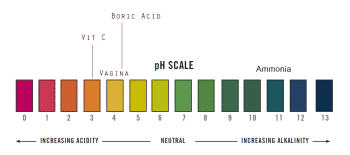A strong ammonia smell coming from your vagina is due to an overgrowth of certain ammonia-producing bacteria.
Bacteria have various abilities to produce ammonia, with the pH of the environment and the type of bacteria largely dictating just how much is produced. Some bacteria produce more ammonia when the vagina is alkaline, which is what BV-causing bacteria tend to do.
Bacteria may produce ammonia in a few different ways, with the main method that would cause an ammonia vaginal odour being an enzyme called urease. Urease breaks down urea into ammonia and carbon.
Treating the bacteria that cause your vagina to smell like ammonia
The important thing to understand here is that not every microbe produces ammonia odours in the vagina, and ammonia odour means it’s highly likely you have a very specific bacteria present. It doesn’t mean this bacteria is the only one present (BV bacteria typically work in teams), but it will help you figure out what treatment – at least for that bacteria – is going to suit you best.
Vaginal colonising microbes that produce ammonia
Microbes that produce the most ammonia are typically gram-negative anaerobic species, clostridia, enterobacteria and Bacillus spp., while gram-positive, streptococci and micrococci produce modest amounts. Lactobacilli and yeast produce very little ammonia.
(This list is incomplete – we’re still working on this! Most bacteria use and/or produce ammonia, but we’re just establishing the ones that cause the odour in the vagina specifically.)
- Helicobacter pylori
- Proteus mirabilis
- Proteus vulgaris
- Ureaplasma urealyticum
- Cryptococcus spp.
- Helicobacter pylori
- Klebsiella spp.
- Possibly Serratia spp.
In bacterial vaginosis (BV), teamwork between different bacterial species, and indeed the presence of some bacteria over others, can mean the odour is less fishy and more ammonic.
How ammonia can change the environment of your vagina
Ammonia’s pH can change, but it is typically very alkaline, with the bottle of ammonia in the laundry cupboard having a pH of about 11 (blue in the diagram below). Remember that a healthy vagina is acidic, a pH of about 4, while water is neutral at a pH of 7.

Ammonia in the vagina, excreted by microbes, has an alkalising effect. This means the pH of the vagina goes up, past its healthy level, and into the danger zone of BV.
How is ammonia made in the vagina by microbes?
Ammonia is made all throughout your body in different systems and processes, playing a role in your urinary system, digestive system, and your vagina.
In the intestines, ammonia is made from the breakdown of proteins, which your liver then turns into urea, which is what you excrete in your urine. Microbes use ammonia as a source of nitrogen.
Most bacteria form less ammonia at the acidic pH of 5.0 compared to that produced at a more neutral pH of 7.0.

Get a fresh perspective with a qualified, experienced vulvovaginal specialist naturopath.
This product has multiple variants. The options may be chosen on the product page
The most comprehensive vaginal microbiome test you can take at home, brought to you by world-leading vaginal microbiome scientists at Juno Bio.
Easy-to-use BV and AV treatment program.

Promote and support a protective vaginal microbiome with tailored probiotic species.






